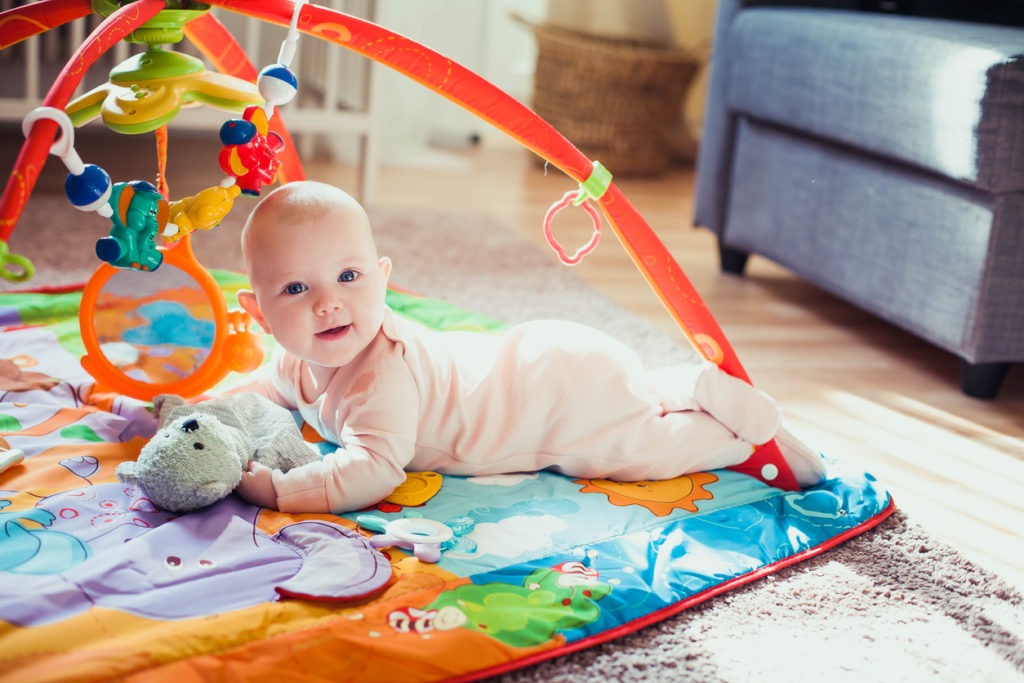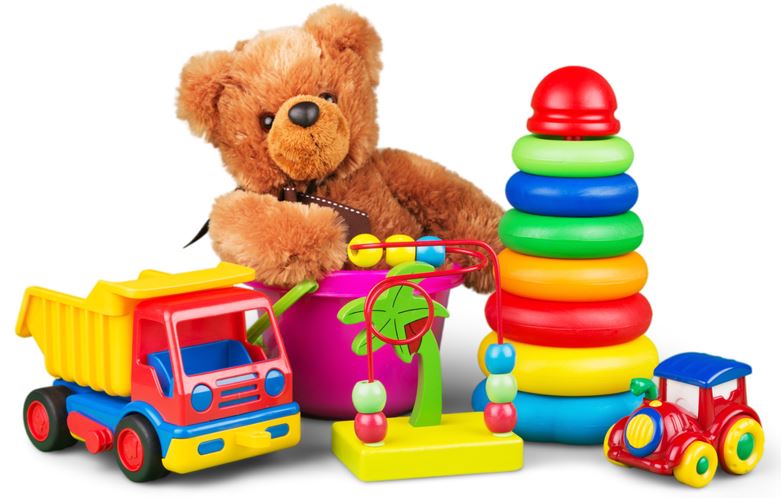Playing with toys is essential for your baby’s growth. As soon as your baby is a month old and starting to become aware of their surroundings, you can start. Your baby learns and develops social, problem-solving, and emotional skills over time by interacting with toys. Playing with your imagination is even better because your child may pick up on sounds, feelings, body language, and other signs. Toys will be a crucial component of connecting with and fostering your child’s growth starting at a young age.
What to look for when buying baby toys?
Parents and other caregivers are advised by the American Academy of Pediatrics (AAP) to continue with conventional baby toys. Flashing screens and digital gadgets may seem like the hottest new thing, but they may not be good for your infant’s developing brain and body.
Here are some tips on selecting toys:
- Try to select interactive and imaginative toys. If you can find toys that help your youngster practice their fine motor or gross motor skills, that’s an added bonus.
- Be aware that choking hazards are among toys’ largest hazards. Baby choking dangers include marbles, coins, toys that a baby can squeeze into their mouths, small balls, button batteries, beads, and balloons.
- Babies shouldn’t be allowed to sleep with any toys, especially plush toys and blankets. Until a child is at least a year old, the AAP advises keeping soft items and blankets out of the crib.
- To determine the appropriate age range for a toy, check the label or description. Most will provide you with a general range of ages that it is meant to accommodate. Try using common sense.
- Keep in mind that babies eat almost anything. Make sure that anything you’re purchasing is free of BPA and other ambiguous elements, and that it is created from natural materials whenever that is possible.
- Don’t worry too much about toys that are sold as instructive. Not forcing babies to memorize facts or the alphabet is the objective. Instead, it’s to provide chances for communication and closeness.
- Make use of a lot of books. These will support the development of creativity and thought.
- Be on the lookout for toys that might encourage stereotypes. These might be racially or gender- related.
Best Baby Toys for Various Stages
Here are the different stages you’ll see when your child begins to interact with toys more, as well as the different plaything categories that will keep him entertained from infancy through toddlerhood.
Birth to 2 months old
When you are holding your newborn, one of the most exciting things he will gaze at will be your happy face because newborns can only see items that are 8 to 12 inches away at this age. When a baby is a newborn, playing and quality time are synonymous, and as you hold, touch, and converse with him, he will have all the entertainment he needs.
Babies learn about the world through touch, sight, and hearing, therefore some of the finest toys for a one-month-old may include playthings with contrasting colors, gentle sounds, and various textures. Think of colorful, eye-catching mobiles, playmats with toys hanging from them, and tactile rattles.
You can play with your baby by lightly shaking a rattle close to him to see whether he responds to the sound. Alternatively, position a brightly colored toy 8 to 10 inches away from his face and let your infant to follow it with his gaze. Another fantastic fun is to put the infant on his stomach for “tummy time,” which will help him develop the little muscles in his arms and legs.
Best toys: mobile in bold patterns, playmats with hanging toys, rattles
2 to 4 months old
The mobile and the playmat with the vibrantly contrasted colors will continue to keep their attraction because your baby will still appreciate many of the same toys he did when he was a newborn. But by the time he is four months old, he will probably love clutching and shaking objects like rattles and swinging at toys that are dangling from his playmat (as opposed to just staring at them).
Around this age, he’ll also enjoy soft, multi-textured rattles, cloth or board books, and unbreakable, baby-friendly mirrors, among other things. He will smile at his own reflection even though he is unaware that he is doing so.
At this moment, you can also play with your baby by having him shake the rattle (with your help). By moving the rattle and hearing the sound it creates, he will start to learn about cause and effect. He’ll start shaking it on his own quite soon.
Best toys: mobile, playmat with hanging toys, multi-textured rattles, cloth or board books, baby-friendly mirrors
4 to 6 months old
Your infant can now manipulate his head, hands, and legs with more ease. He can roll over, lift himself up onto his arms, and even kick something. By month 6, he’ll probably be able to pass toys from hand to hand because 4- to 6-month-olds also have stronger hand-eye coordination than newborns.
Activity mats will still be appealing to babies who are 4 and 5 months old, but you may also introduce books with multiple textures and toys that generate noise when your baby shakes, squeezes, or presses them. Playthings that are simple for him to grab and hold onto as well as put into his mouth, such as sturdy board books, soft balls, and teething toys, will be his favorites in particular.
He’ll also enjoy plush animals (and may decide to keep one as a regular companion), an activity table or a busy box with levers and sounds, which will help him learn about cause and effect and give him a renewed sense of independence. Simply demonstrate what to do and watch him go.
A word of caution: Since babies are prone to exploring with their mouths at this age, you should keep choking risks such tiny toys, marbles, magnets, and other small things out of his reach.
Best toys: activity mats, multi-textured books and toys, sturdy board books, soft balls, teething toys, stuffed animals, a busy box with lever and sounds
6 to 12 months old
During the second half of his first year, your developing baby will accomplish several significant milestones. He’ll learn to sit up, stand up by himself, cruise (walk while hanging onto furniture), and possibly even take his first steps between the ages of 6 and 12 months. All of these skills provide your baby a fresh perspective on his toys (and how he plays with them).
Additionally, he will begin to comprehend the idea of object permanence, which states that even though something leaves his field of vision, it still exists. And he will advance from using his hand to rake a toy in his direction to picking things up with his thumb and forefinger (known as the pincer grasp).
Even though it’s not a toy, you can give your 6- to 12-month-old anything that’s secure for him to explore. Babies may start to play more independently at this age, while your little one may initially need to follow your direction. Good choices include cars or balls that will entice your baby to crawl after them as well as toys that play music when your baby pushes or clicks a button.
Standing toys like activity tables and stacking rings that your baby can push and balance upright are particularly beneficial for 7- and 8-month-olds.
Of course, your baby will still enjoy some of their earlier favorites, such as stuffed animals and board books. Not to mention that household things like measuring cups, wooden spoons, and plastic containers may all be turned into toys.
In particular, the push- and pull-toys that he may use to hone his walking techniques will keep him entertained well into his second year. Purchasing pretend play items like play food, strollers, and shopping carts is also a fantastic idea right now.
Best toys: toys that play music, toy car, balls, activity tables, stacking rings, shape sorters, simple puzzles, stacking toys, puppets, board books, stuffed animals, measuring caps, wooden spoons, plastic containers, push-and-pull-toys, toy strollers, shopping carts, play food
Conclusion
Play is more than just a chance to have fun when it comes to a child’s health and development. Hide-and-seek, pat-a-cake, and peek-a-boo are just a few of the several types of play that have a substantial positive impact on a child’s brain, body, and quality of life.
Play can teach kids how to be more organized, plan ahead, get along with others, and control their emotions, according to study. Play enhances children’s language, numeracy, social skills, and even their ability to manage stress.


